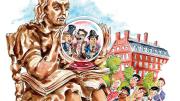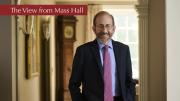To secure its identity as The Ohio State University, it engaged in a three-year struggle to trademark the word “The” in its name. This made for many jokes in the media and academic circles, but it is just one particularly absurd (and expensive) example of the widespread focus on brand identity within American higher education.
During the past few decades, U.S. colleges and universities have devoted considerable effort to establishing a distinct brand. Legally enforced trademarks have been at the center of this strategy, initially focused on college names and symbols. But the practice expanded to include tag lines proclaiming institutional mission and program names, implying that universities’ core activities are unique and proprietary. The term “the first-year college experience” is now registered to the University of South Carolina, as if it denotes something particular to that university rather than a common feature of higher education. Branding helps institutions succeed in today’s highly competitive higher education landscape.
The Quest for Brand Identity in Higher Education
Charles William Eliot, the legendary president (1869-1909) who transformed Harvard into a modern research university, had a different brand problem. In the late nineteenth century, when he set out to reform Harvard, higher-education institutions were similar and the bachelor of arts degree signified the same attainment whatever institution awarded it. Eliot feared that his efforts to improve Harvard would come to naught if students could obtain the same degree at less rigorous institutions; at the time, the brand recognition of a college degree was stronger than Harvard’s own brand. Thus, he devoted considerable work to making the reforms he was instituting at Harvard normative across American higher education. As Eliot strove to make Harvard great, he wanted other institutions to be its near equal. Harvard could not excel, he believed, if the rest of the sector was weak.
Were he alive today, Eliot could be confident that Harvard’s brand trumped that of the bachelor’s degree. Does that mean that his successors need not be concerned about the health of the many other institutions that make up higher education? Not at all. The nearly exclusive focus of higher education leaders on their own institutions’ reputations comes at considerable peril. Although competition among schools has long been viewed as a key to the greatness of American higher education, developments during the last half-century have knocked the balance between competition and cooperation out of whack—and excessive competition is hurting the whole system.
The Impact of Financial Aid and Merit Scholarships
The focus on differentiation via branding is just one manifestation of this intensifying competition in higher education. Consider troubling changes in the use of financial aid. Beginning in the 1990s, scholarships and related support were increasingly tethered to student recruitment through “merit aid” and other forms of tuition discounts. Despite abundant research demonstrating that merit aid favors students from upper-income families, most schools abandoned need-only aid policies to compete for students with high SATs and GPAs and to increase the proportion of admitted students who enroll; this helped improve their position in the powerful U.S. News & World Report rankings—but at a cost to the truly needy. For example, Marcus, whose parents could afford expensive SAT tutoring, might pay much less in tuition at the same college as Maria, who did well in high school, but whose family could not pay for private test preparation. Amplified across the system, many thousands of students from low-income families pay more in tuition than their affluent peers. The small number of schools that continued to provide need-only aid were typically those with strong national reputations that had already achieved high rankings.
Even these elite institutions soon found ways to use financial aid in student recruitment. In 2001, Princeton eliminated loans from its aid program. In short succession, other leading institutions found ways to increase their affordability; Harvard’s own generous policy, now covering full costs for students from families with annual incomes below $75,000 and partial costs for many families with higher incomes, was forged in this period. Recently, Princeton upped its aid to cover full costs for families with incomes up to $100,000. Because of these generous policies, a small number of well-resourced private institutions provide what public universities were created to offer: free or low-cost, high-quality higher education.
Practices that make once-exclusive universities financially affordable are in themselves good. But given their small enrollments, these institutions cannot offset the impact of the rising cost of tuition in the far larger, and increasingly resource-strapped, public sector. In addition, the elite, well-endowed institutions’ generous policies can have unintended consequences. High school students with access to enough information about how higher education operates aspire to attend the same small number of schools, driving up the number of applications and driving down admission rates. Anna, who has an engaged high school counselor who encourages her to apply to Ivy League schools, may pay much less for college than Dwayne, who assumes that private schools are too expensive and only applies to a nearby public university. Children whose parents do not know much about higher education and who do not have access to high-quality college counseling will assume that less prestigious schools cost less. But the rest flock to the small number of universities with generous financial aid. This increases the prestige of those schools and forces the rest to compete for the remaining students with tactics that may not improve the quality of students’ education or strengthen higher education generally, nor serve the society that depends on it for educated citizens.
In addition, applicants think that they will not receive equivalent benefits if they attend colleges with fewer resources. This creates indirect problems even for the most prestigious universities, the seeming beneficiaries of their growing applicant pools. One obvious problem is the public attention it attracts to their admissions practices. Lawsuits about affirmative action—like the Students for Fair Admissions litigation against Harvard, now awaiting a decision from the Supreme Court—are driven, in part, by applicants’ view that the stakes of not attending “the best” university are high. And as we are now seeing, affirmative action is just one aspect of the heightened scrutiny of elite universities’ admissions practices. Legacy preferences, advantages for athletes, and eventually the whole apparatus of holistic review will be criticized. Recent research shows that holistic review, often portrayed as fairer than just considering test scores and academic records alone, favors students from well-to-do families. So elite institutions increasingly face criticism from all sides. Similarly, scrutiny of wealthy institutions’ endowments and investment practices has become more intense. Education has become politicized at every level: what is taught, who teaches, and other staffing decisions have all become potential flash points.
Increased stratification of higher education in the past few decades has sparked public hostility toward elite universities. That stratification is related to other developments in higher education:
• uneven or declining public support for higher education, from state and federal sources;
• rising costs of tuition at private and public colleges and universities;
• decreasing value of federal financial aid, relative to rising student costs of attendance;
• massively growing student debt;
• shifting reasons for attending college, with extrinsic motives, particularly anticipated earnings, taking priority over intrinsic ones, such as learning, and the associated pivot from academic majors to vocational ones;
• institutions prioritizing research that will generate income through practices such as patenting and corporate partnerships; and
• institutions seeking to save money through strategies that decrease the quality of education, such as relying on part-time faculty or contracting out important services.
Increased competition is both a consequence and a cause of these developments. Taken together, they signal major changes in higher education as a whole—and threats that individual pursuit of institutional advantage cannot address adequately.
Financial resources buffer Harvard from most of the negative impacts of these trends. But the University cannot be completely insulated from problems in higher education generally. For example, Harvard’s graduate programs are affected by the availability of faculty positions, which have been shrinking since the late 1970s. The academic job market was first affected by the growth of vocational majors, which require faculty with professional experience rather than academic training. This led colleges to hire practitioners off the tenure track to teach applied courses. Financial constraints intensified the shift away from full-time, tenure-track faculty as institutions relied on contingent faculty in academic subjects as well. More recently, institutions such as Henderson State University, in Arkansas, have eliminated academic departments that were once seen as the heart of higher education, including English, biology, and mathematics. Such changes are reported with increasing frequency in the higher education media. The weak academic job market, in turn, feeds graduate student dissatisfaction and unionization efforts. As more regional public universities eliminate academic departments, the job market may collapse, forcing responsible research universities to close some of their Ph.D. programs, disrupting the training of new scholars and the discovery of new knowledge.
These trends threaten the meaning of a college education. Once Eliot popularized the elective system, college ceased to be a uniform experience. This introduced variation into American higher education and a countervailing desire to define the purpose and meaning of college. The healthy tension between diversity in the system and a sustained discussion of what college education should be produced some widely shared ideas and practices. For example, following the crisis of World War II, James Bryant Conant, Harvard’s president from 1933-1953, helped create a widely adopted model of general education when he commissioned the report, General Education in a Free Society (also known as the “Harvard Redbook”). But higher education no longer seeks to foster such common practices and understandings. As leaders focus on their own institutions’ competitive advantages, they are less interested in defining what higher education writ large should be. When colleges revamp their general education, for example, they want to create “signature” programs that are distinctive—not common.
The Erosion of the Bachelor’s Degree’s Value
American higher education remains strong. But imagine the dire consequences if these trends continue. Like the high school degree before it, the bachelor’s degree may cease to be a meaningful signal of educational attainment. College graduates, whatever their actual achievements, will have difficulty establishing their worth without other advantages, such as personal connections, internships, or the prestige of their institutions. There are already indications that this is happening as institutional reputation and choice of field seem to have a growing importance in students’ financial returns from completing college. More graduates now seek advanced degrees to gain an advantage in the job market.
If the value of the bachelor’s degree becomes meaningless, higher education will cease to fuel social mobility.
If the brand—the value—of the bachelor’s degree becomes meaningless, higher education will cease to fuel social mobility. Many college graduates will find themselves worse off as they carry heavy student debt without realizing significant income gains. We will become a less educated society as more young people see little value in doing well in high school or pursuing a college degree.
A Call for Sector-Wide Cooperation and Renewal
We desperately need to focus attention on the health of the sector as a whole. Our college and university leaders need to reclaim the tradition of Charles Eliot, who simultaneously built Harvard while also trying to advance all American higher education. With their brands secure, Harvard and its peer institutions are in a strong position to take on this challenge.
What might this mean in practice? One step will involve creating relationships and alliances with leaders from a wide variety of institutions to both understand their different concerns and to explore areas of common purpose. For a new era of cooperation in and renewal of higher education to succeed, it must be based on broad engagement and equal involvement of all kinds of institutions.
Another step will involve revitalizing higher education associations or creating new organizations, so we have effective instruments for collective inquiry and action. Although professional associations representing parts of higher education exist, they have limited influence over public policy or institutional behavior. Eliot saw these kinds of organizations as key to his reform agenda and took leadership roles in several. Leaders of our strongest universities need to do the same if we are going to be able to identify and implement solutions to sector-wide problems. In addition, wealthy institutions have lobbyists and alumni communities who are activated to support their institutions’ interests. They should also be mobilized to support policies that strengthen public higher education and the broader sector, such as funding increases; to oppose legislation that places inappropriate restrictions on institutions, such as bills forbidding the teaching of “critical race theory”; and to challenge accountability measures that impose too limited understanding of the aims of higher education.
Well-resourced institutions can also demonstrate their commitment to higher education more broadly by creating cooperative alliances with area institutions to share resources—perhaps by providing access to costly journal subscriptions and rich library collections; or by allowing students from those institutions to enroll in classes not offered at their schools; or by helping support research by faculty at partner institutions; or by financing post-doctoral fellowships for their recent Ph.D.s to teach at other schools for a number of years. They can withdraw from activities, such as rankings, that are shown to be of little value to students and inimical to higher education generally.
Finally, and most importantly, the elite institutions can—and must—reignite conversations about the meaning of a college education. Like Conant in the aftermath of World War II, they can encourage discussion about the core knowledge and skills that all graduates should have in this historical moment—a time of growing global inequality, intense political polarization, increased human migration, new technologies for communication, and climate change. They can raise up higher education’s core values and spark discussion about how those values should guide institutional practices. These conversations will not lead to consensus, but nonetheless can sustain a meaningful sense of common enterprise and support a range of thoughtful responses essential to sustaining higher education in the knowledge- and research-dependent decades ahead.
This change in orientation will not be easy. University presidents already have immense demands on their time and attention. The governing boards they report to naturally want them to focus on their own institutions. Differentiation and stratification of the sector make it difficult to see common interests and to work together. Federal policies discourage cooperative action. The current political context places higher education in a defensive position. It’s tempting to hunker down and continue to act as if each institution is in a competitive battle with its peers for advantage rather than part of a larger sector that is struggling for survival. But crisis can elicit creativity and new opportunities. May this one inspire fewer trademarks and more collective action on behalf of meaningful, quality higher education for all who seek it.









